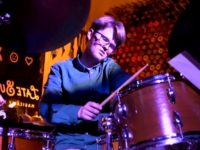When I listen to Jon Hatamiya’s new album More Than Anything, I wonder why aren’t there more trombonists out there who lead jazz bands with a rock persuasion (Reut Regev’s R*Time might be one example, but there aren’t many). When used right, the trombone can go into any realm of music that a sax or a trumpet can venture into and thrive. Maybe Hatamiya is approaching his debut album with a mindset befitting his youth, not so beholden to tradition so as to make another de facto JJ Johnson or Curtis Fuller tribute.
In any case, Hatamiya tips off ambitious intentions even before the proverbial needle drops; for his first go at it, he assembled your basic jazz quintet, with Albert Baliwas on alto sax, Jacob Mann on piano, Logan Kane on bass and Colin McDaniel on drums. But it’s a ‘quartet’ that is supplemented with two electric guitarists in Colin Cook and Yunus Iyriboz. That in itself doesn’t guarantee anything earth-shattering, of course; the songs have to fit with the instruments deployed, and vice versa.
On his first time out, Jon Hatamiya’s got that all figured out. He’s crafted a very modern sound that’s used in the service of compositions that are elaborate but not weighed down by an overwrought approach. In fact, ‘approachable’ is an apt way to describe what are essentially complex songs because Hatamiya can make it all go down easy and his sense of song development is spot on, often using a dash of unpredictability. For instance, “What Means This?” is a keen modern jazz composition and the snaky Hatamiya/Baliwas lines really sell it as such, but the tart sonority of Cook and Iyriboz’s guitars that rear up at certain times temporarily pull the song toward another realm. It’s a mild schizophrenia that makes you pay attention.
There are other examples of Hatamiya creating sparks by rubbing together two of more different styles. “Dreamscape” opens with power rock chords but quickly settles into a nimble sequence of notes presented by the two horns. The rock ‘ying’ and jazz ‘yang ‘of the song tug the song in both directions, and the psychedelic middle section of the song flirts with going awry as the band creates a lot of noise before snapping back into its engaging theme. After a quiet, delicate intro “The Little Island (Dreamscape 2)” breaks open into a contemporary, drums ‘n’ bass affair and Hatamiya trades fours with Baliwas. Then as well, “You Think you Know (Dreamscape 3)” opens with a somber phase, performed initially by Mann alone and featuring Mann throughout. It’s a Metheny-esque, through-composed piece developing at an unhurried pace with yawning guitars and a folkish melodicism that calls to mind Brian Blade’s Fellowship band.
Though a trombonist is writing these songs, that trombonist obviously thinks about how each player fits into the song; the main motif of “How Things Change” is a bass line, and it probably wouldn’t be as effective carried out any other way. True to the song’s title, an entirely different motif is introduced halfway in, this time executed by piano and as Baliwas’ sax takes flight. The song sneakily returns to the original theme but this time with that second bass line.
“Why” uncovers even more intelligence in the composing acumen of Jon Hatamiya, full of lovely little turns and humanity, especially underscored by Kane’s standup bass solo and the leader’s own lyrical run. The closer “Song” flows freely, moving at a measure that’s only implied as the melody finds its way up and down alleys of discovery.
Using a veteran-level of savvy into his trombone, songwriting and arrangements, Jon Hatamiya has put together a set of recordings where every single track sounds fresh and full of ingenuity applied to all the little details. That makes More Than Anything easily one of the best jazz debut recordings that you’ll hear in 2020.
Get More Than Anything now, from Orenda Records.




